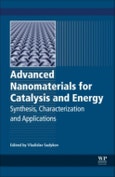Advanced Nanomaterials for Catalysis and Energy: Synthesis, Characterization and Applications outlines new approaches to the synthesis of nanomaterials (synthesis in flow conditions, laser electrodispersion of single metals or alloys on carbon or oxide supports, mechanochemistry, sol-gel routes, etc.) to provide systems with a narrow particle size distribution, controlled metal-support interaction and nanocomposites with uniform spatial distribution of domains of different phases, even in dense sintered materials. Methods for characterization of real structure and surface properties of nanomaterials are discussed, including synchrotron radiation diffraction and X-ray photoelectron spectroscopy studies, neutronography, transmission/scanning electron microscopy with elemental analysis, and more.
The book covers the effect of nanosystems' composition, bulk and surface properties, metal-support interaction, particle size and morphology, deposition density, etc. on their functional properties (transport features, catalytic activity and reaction mechanism). Finally, it includes examples of various developed nanostructured solid electrolytes and mixed ionic-electronic conductors as materials in solid oxide fuel cells and asymmetric supported membranes for oxygen and hydrogen separation.
Please Note: This is an On Demand product, delivery may take up to 11 working days after payment has been received.
Table of Contents
1. Synthesis of Nano-Catalysts in Flow Conditions Using Millimixers 2. Influence of Hydrodynamics on Wet Syntheses of Nanomaterials 3. Advanced Size-Selected Catalysts Prepared by Laser Electrodispersion 4. Ruthenium Nanomaterials: An Overview of Recent Developments in Colloidal Synthesis, Properties, and Potential Applications 5. Ag-Containing Nanomaterials in Heterogeneous Catalysis: Advances and Recent Trends 6. How Does the Surface Structure of Ni-Fe Nanoalloys Control Carbon Formation During Methane Steam/Dry Reforming? 7. Recent Applications of Nanometal Oxide Catalysts in Oxidation Reactions 8. Particle-Size Effect in Catalytic Oxidation Over Pt Nanoparticles 9. Novel Zeolite Catalysts for Methanol to Hydrocarbon Transformation 10. Semiconductor Photocatalysts Based on Nanostructured Cd12xZnxS Solid Solutions in the Reaction of Hydrogen Evolution From Aqueous Solutions of Inorganic Electron Donors Under Visible Light 11. Nanocomposite Alkali-Ion Solid Electrolytes 12. Advanced Materials for Solid Oxide Fuel Cells and Membrane Catalytic Reactors 13. Mixed Ionic-Electronic Conducting Perovskites as Nanostructured Ferroelastics








